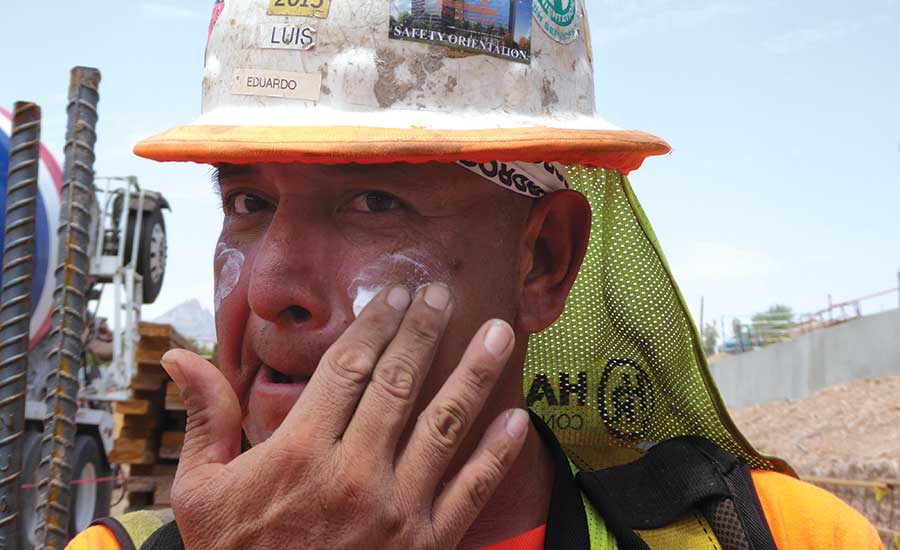Shade tents and frequent water breaks are part of the strategies Kris Comon uses for dealing with 100°-plus temperatures and a punishing sun at a two-story building being constructed in Phoenix. Comon is project manager for UEB Builders, prime contractor for the Helios Education Foundation, and to beat the heat, work starts at 6 a.m. and ends in the early afternoon, he says.
A growing awareness of the dangers of summer work and of sun rays as a cause of skin cancer on and off the job has driven employers, unions and workers to limit exposure. Insurers and risk managers should take note, too. In sun-drenched Australia, workers’ compensation claims related to sun damage have been a fact of life. Workers filed about 175 claims a year between 2000 and 2012, resulting in $63 million in payments, according to a study by Cancer Council Australia.
And while data about U.S. sun-related workers’ comp claims is hard to find, contractors and engineering firms are increasingly aware of the hazard. “Generally, workers’ comp schemes are not designed for temporary conditions,” such as sunburn, says J. Carin Burford, a shareholder at Ogletree Deakins in Birmingham, Ala., who helps defend companies against claims. However, “sunburn or sun exposure could be compensable in certain cases,” she says.
Interpretation of Rule
While sun exposure is not directly cited as a potential hazard under federal rules requiring employers to provide protective equipment, the U.S. Occupational Health and Safety Administration has interpreted the rule as extending indirectly to solar radiation, Burford says.
To protect workers and guard against claims and lawsuits, construction companies should provide sun-protective shirts, glasses, sunscreen and other gear, she says. In addition, contractors should include sun protection in trainings for new workers and should make it a policy to discipline workers who don’t use protective clothing and sunscreen, according to Burford.
Alternatives to protective clothing, shade tents and sunscreen can seem inviting, but the Food and Drug Administration has investigated sun protection pills on the market and flagged misleading advertising by four brands for suggesting a single pill can provide adequate protection.
The FDA found that only one supplement, Heliocare, was effective, according to Dr. Clarissa Yang, chief of dermatology at Tufts Medical Center in Boston. That’s due to the pill’s main ingredient, Polypodium leucotomos extract. Even so, the pill only provides limited protection equivalent to 3 to 5 SPF, she notes.
How best to motivate workers to apply, and then, after perspiring during work, reapply sunscreen? Sonia Duffy, a professor of nursing care at Ohio State University, has studied the health of members of operating engineers Local 324 in Michigan. In a study published four years ago, Duffy and her co-authors learned that most of the workers sustained a sunburn over the years and found that many local members were lax about applying sunscreen. In a recently published study, Duffy and her co-authors looked at how operating engineers responded to different mixtures of sun-care education and reminders—including photos of skin-cancer victims. Some workers received only training, some training and text-message reminders, some education and mailed sunscreen, and others education, reminders and mailed sunscreen. Overall, the most effective part of the study was the half-hour educational session. After that, “employees in the groups not receiving the sunscreen from us went out and bought it for themselves,” Duffy says.
Out on the jobsites this summer, neck shields and wide-brim protective helmets are popular—with good reason. The Skin Cancer Foundation says about 175,000 cases of potentially deadly melanoma will be diagnosed in the U.S. this year, up 50% from a decade ago.





